Tanshinone IIA and Cryptotanshinone Prevent Mitochondrial Dysfunction in Hypoxia-Induced H9c2 Cells: Association to Mitochondrial ROS, Intracellular Nitric Oxide, and Calcium Levels
- PMID: 23533503
- PMCID: PMC3603679
- DOI: 10.1155/2013/610694
Tanshinone IIA and Cryptotanshinone Prevent Mitochondrial Dysfunction in Hypoxia-Induced H9c2 Cells: Association to Mitochondrial ROS, Intracellular Nitric Oxide, and Calcium Levels
Abstract
The protective actions of tanshinones on hypoxia-induced cell damages have been reported, although the mechanisms have not been fully elucidated. Given the importance of nitric oxide (NO) and reactive oxygen species (ROS) in regulation of cell functions, the present study investigated the effects of two major tanshinones, Tanshinone IIA (TIIA) and cryptotanshinone (CT), on hypoxia-induced myocardial cell injury and its relationships with intracellular NO and ROS, calcium, and ATP levels in H9c2 cells. Chronic hypoxia significantly reduced cell viability which accompanied with LDH release, increase in mitochondrial ROS, intracellular NO and calcium levels, decrease in superoxide dismutase (SOD) activity, and cellular ATP contents. TIIA and CT significantly prevented cell injury by increasing cell viability and decreasing LDH release. The protective effects of tanshinones were associated with reduced mitochondrial superoxide production and enhanced mitochondrial SOD activity. Tanshinones significantly reduced intracellular NO and Ca(2+) levels. ATP levels were also restored by TIIA. These findings suggest that the cytoprotective actions of tanshinones may involve regulation of intracellular NO, Ca(2+), ATP productions, mitochondrial superoxide production, and SOD activity, which contribute to their actions against hypoxia injuries.
Figures
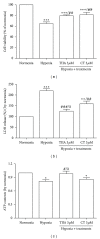
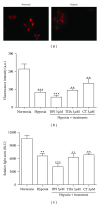

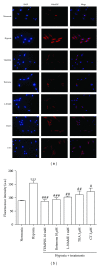
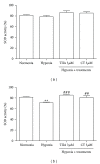
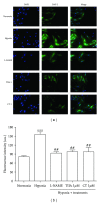

Similar articles
-
TanshinoneIIA and cryptotanshinone protect against hypoxia-induced mitochondrial apoptosis in H9c2 cells.PLoS One. 2013;8(1):e51720. doi: 10.1371/journal.pone.0051720. Epub 2013 Jan 14. PLoS One. 2013. PMID: 23341883 Free PMC article.
-
Roles of reactive oxygen species in methyl jasmonate and nitric oxide-induced tanshinone production in Salvia miltiorrhiza hairy roots.Plant Cell Rep. 2012 May;31(5):873-83. doi: 10.1007/s00299-011-1208-6. Epub 2011 Dec 22. Plant Cell Rep. 2012. PMID: 22189441
-
Preparation and characterisation of solid dispersions of tanshinone IIA, cryptotanshinone and total tanshinones.Asian J Pharm Sci. 2017 Jan;12(1):85-97. doi: 10.1016/j.ajps.2016.08.004. Epub 2016 Aug 31. Asian J Pharm Sci. 2017. PMID: 32104317 Free PMC article.
-
Effects of Salvia miltiorrhiza on CNS Neuronal Injury and Degeneration: A Plausible Complementary Role of Tanshinones and Depsides.Planta Med. 2015 Aug;81(12-13):1003-16. doi: 10.1055/s-0035-1546196. Epub 2015 Jul 17. Planta Med. 2015. PMID: 26190397 Review.
-
Cross Talk Between Mitochondrial Reactive Oxygen Species and Sarcoplasmic Reticulum Calcium in Pulmonary Arterial Smooth Muscle Cells.Adv Exp Med Biol. 2017;967:289-298. doi: 10.1007/978-3-319-63245-2_17. Adv Exp Med Biol. 2017. PMID: 29047093 Review.
Cited by
-
Tanshinone Protects against Spinal Cord Ischemia-Reperfusion Injury by Inhibiting JNK Activity.Comput Intell Neurosci. 2022 May 11;2022:7619797. doi: 10.1155/2022/7619797. eCollection 2022. Comput Intell Neurosci. 2022. Retraction in: Comput Intell Neurosci. 2022 Dec 26;2022:9858210. doi: 10.1155/2022/9858210. PMID: 35602615 Free PMC article. Retracted.
-
Yiqi Huoxue preserves heart function by upregulating the Sigma-1 receptor in rats with myocardial infarction.Exp Ther Med. 2021 Nov;22(5):1308. doi: 10.3892/etm.2021.10743. Epub 2021 Sep 16. Exp Ther Med. 2021. PMID: 34630662 Free PMC article.
-
Protective Effects of Flavonoids Against Mitochondriopathies and Associated Pathologies: Focus on the Predictive Approach and Personalized Prevention.Int J Mol Sci. 2021 Aug 11;22(16):8649. doi: 10.3390/ijms22168649. Int J Mol Sci. 2021. PMID: 34445360 Free PMC article. Review.
-
The Different Expression Patterns of HSP22, a Late Embryogenesis Abundant-like Protein, in Hypertrophic H9C2 Cells Induced by NaCl and Angiotensin II.Electrolyte Blood Press. 2018 Jun;16(1):1-10. doi: 10.5049/EBP.2018.16.1.1. Epub 2018 Jun 30. Electrolyte Blood Press. 2018. PMID: 30046328 Free PMC article.
-
Mitochondria: A Therapeutic Target for Parkinson's Disease?Int J Mol Sci. 2015 Sep 1;16(9):20704-30. doi: 10.3390/ijms160920704. Int J Mol Sci. 2015. PMID: 26340618 Free PMC article. Review.
References
-
- Cassavaugh J, Lounsbury KM. Hypoxia-mediated biological control. Journal of Cellular Biochemistry. 2011;112(3):735–744. - PubMed
-
- Solaini G, Baracca A, Lenaz G, Sgarbi G. Hypoxia and mitochondrial oxidative metabolism. Biochimica et Biophysica Acta. 2010;1797(6-7):1171–1177. - PubMed
-
- Kolamunne RT, Clare M, Griffiths HR. Mitochondrial superoxide anion radicals mediate induction of apoptosis in cardiac myoblasts exposed to chronic hypoxia. Archives of Biochemistry and Biophysics. 2011;505(2):256–265. - PubMed
LinkOut - more resources
Full Text Sources
Other Literature Sources
Miscellaneous

